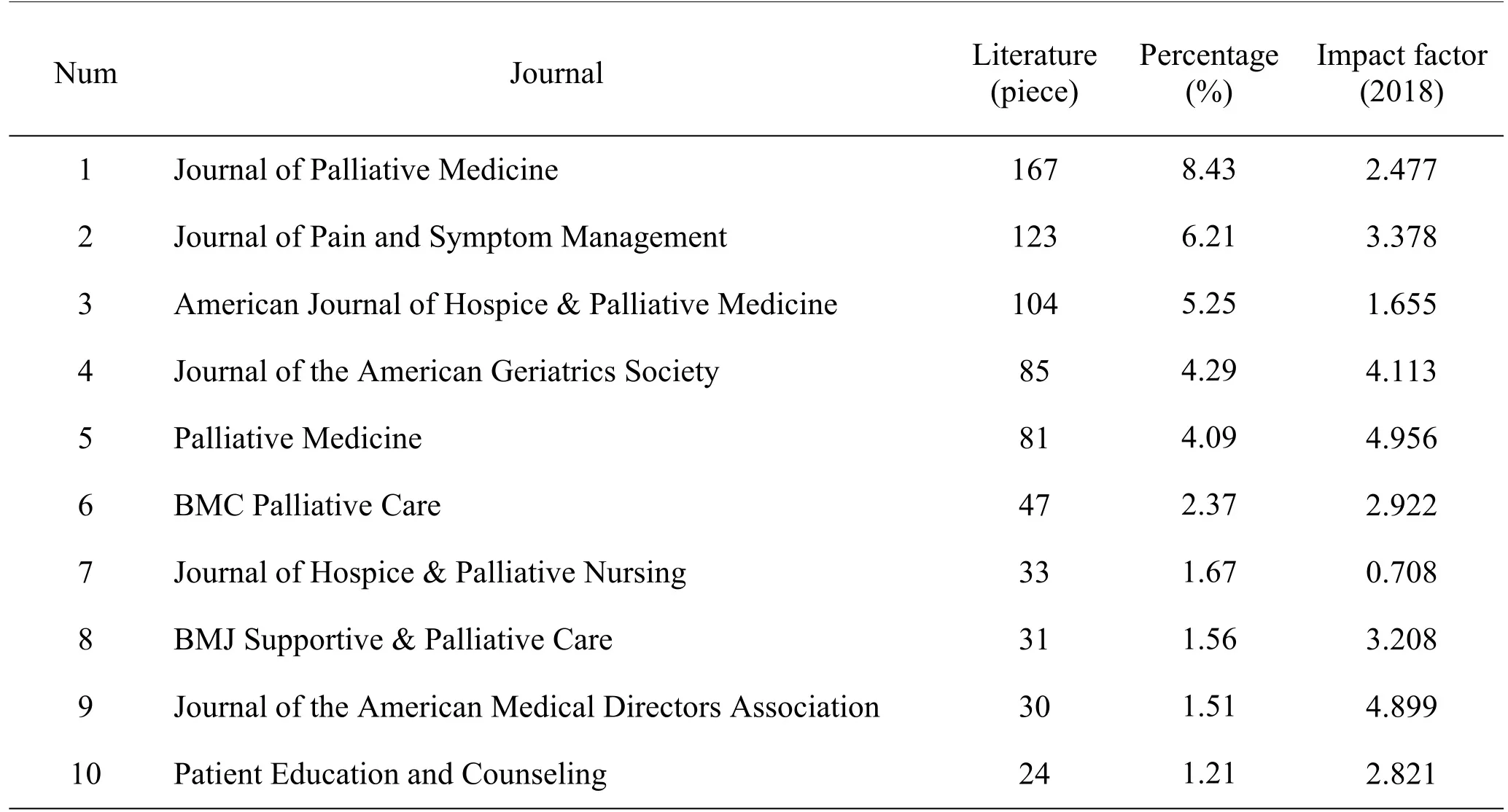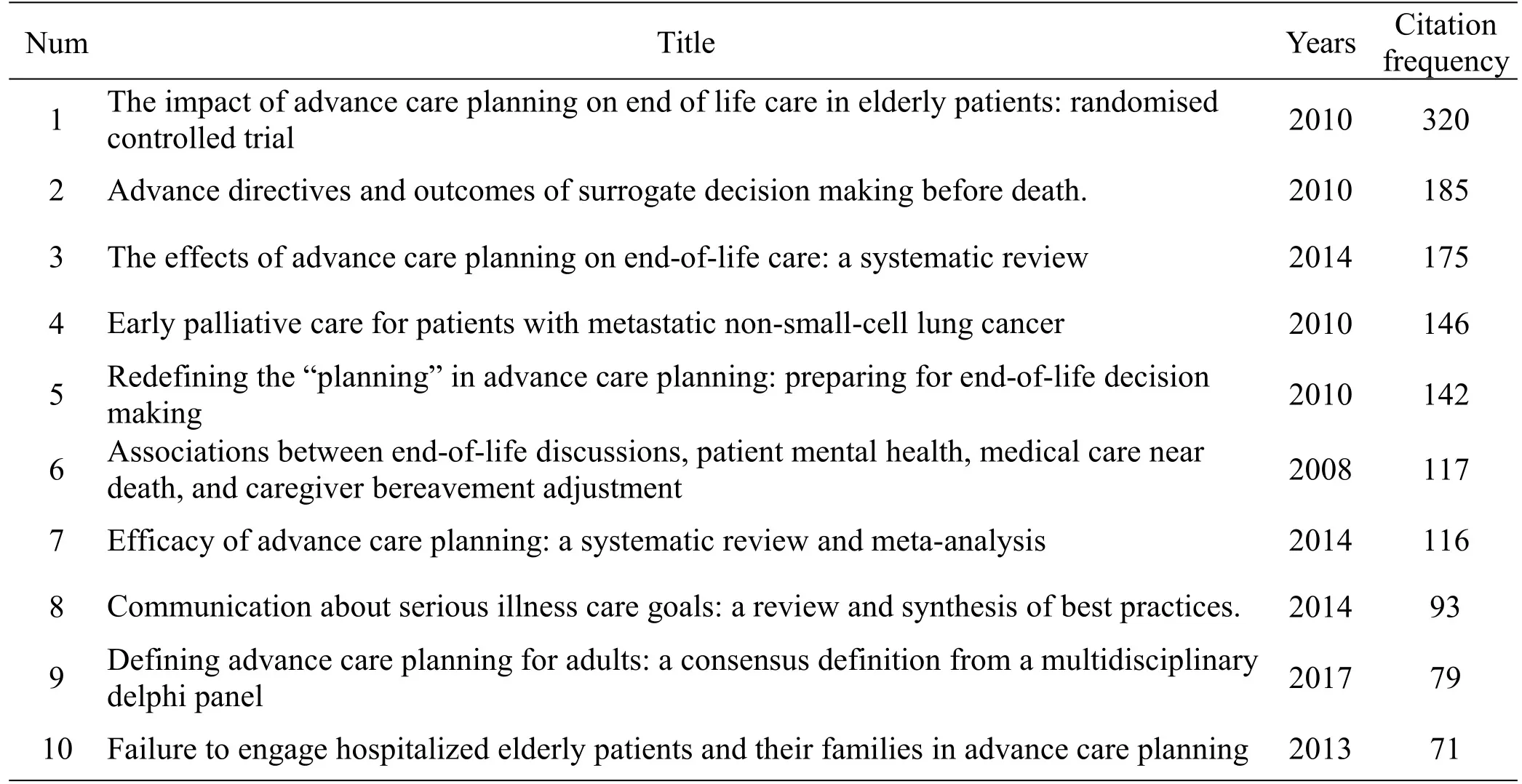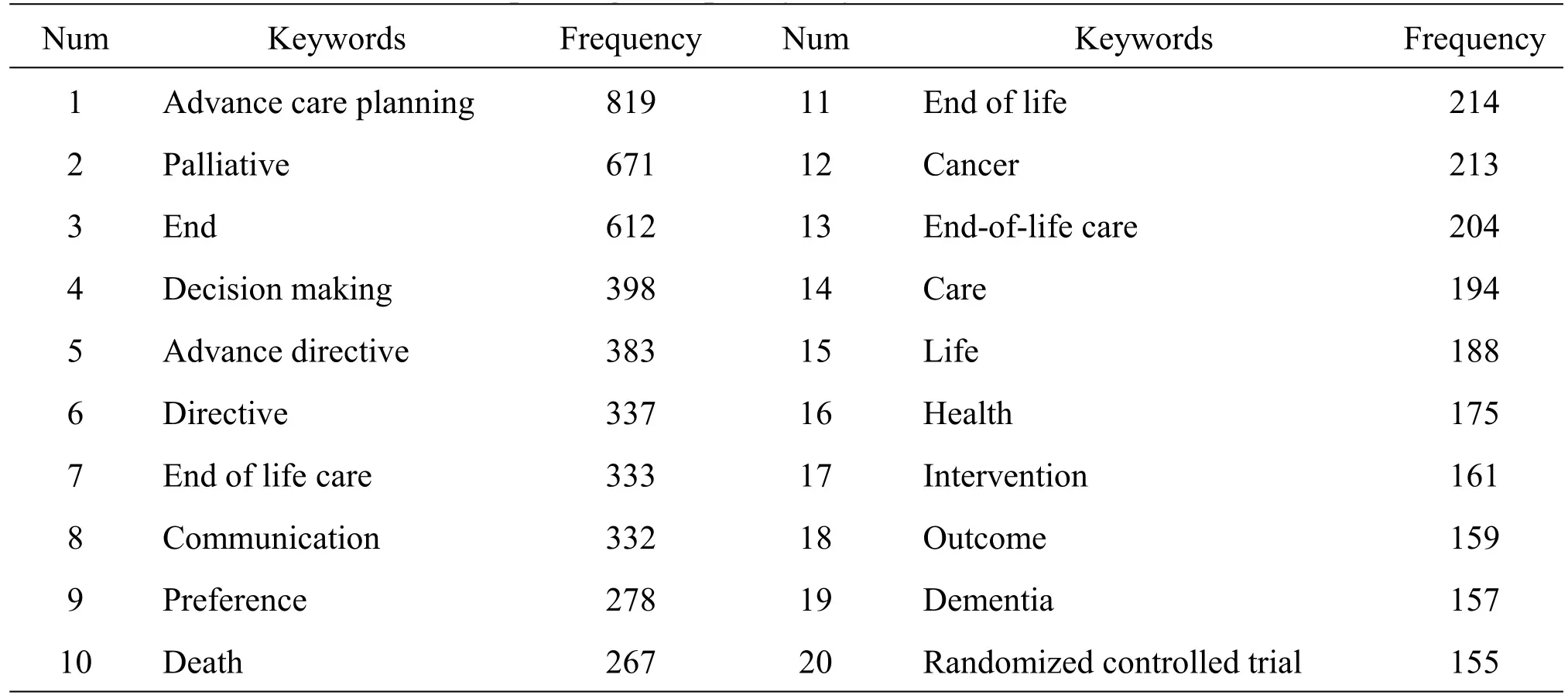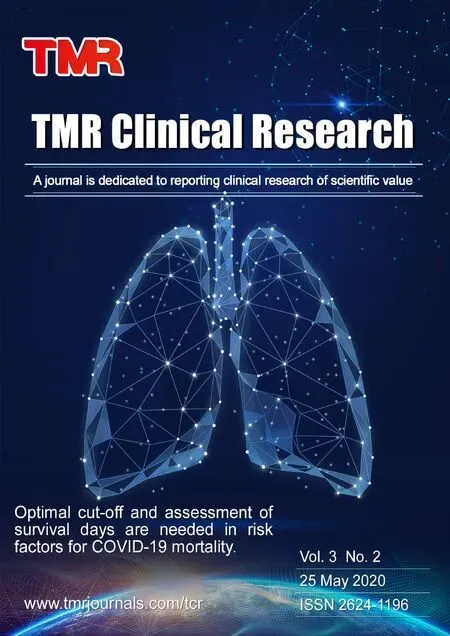Visual analysis of advance care planning related studies
2020-06-12QiWuZhiJianLiuXiaoLiPangLingCheng
Qi Wu ,Zhi-Jian Liu ,Xiao-Li Pang ,Ling Cheng
1Graduate School of Tianjin University of Traditional Chinese Medicine,Tianjin 301617,China.2School of Nursing,Tianjin University of Traditional Chinese Medicine,Tianjin 301617,China.
Abstract Backgroud:To provide a reference for the further development of the field of the advance care planning (ACP),through the visual analysis of the related literature on the ACP.Methods:Taking the core collection database of Web of ScienceTM as data sources,the method of subject word retrieval is adopted.Literature metrology and CiteSpace Ⅴ information visualization software were used to analyze the literature on ACP published from inception to September 2019.Results:A total of 1,981 literature were included.The number of ACP studies increased,USA published the most literature in the world,followed by Australia,Britain,Canada and the Netherlands and so on.The most leading published journal was the Journal of Palliative Medicine,and the highest impact factor was Palliative Medicine (4.956).Sudore,Rebecca L and Hillary D Lum are the key researcher networks with the largest amount of articles published in ACP field.The research content mainly included the definition,implementation process and implementation effect of ACP.Research focused on palliative care,hospice care,decision-making,communication,patient preference and so on.Conclusion:The studies on ACP is on the rise,the research content is deepening,which suggests that we can learn from the research results of foreign countries in this field and continue to deepen the research in the field of ACP in China.
Keywords:Advance care planning,Bibliometrics,Visual analysis.
Background
Advance care planning (ACP) is a program that supports any age or health stage of the process by which adults understand and share their personal values,life goals and preferences for future health care,the goal is to help and ensure that people get consistent medical services with their values,goals and preferences during severe and chronic conditions [1].ACP can improve the quality of communication between patients and clinicians,reduce unnecessary hospitalizations,increase the use of palliative care,and improve patient satisfaction and quality of life [2].With the improvement of the medical security system,more and more mortal patients,medical personnel and scholars begin to think what we should do to face death.Therefore,many researchers are committed to assisting patients to record and plan their future life and late medical decisions when their cognitive abilities are still good.In order to intuitively reflect the current research hotspots and development trend of relevant research in the field of ACP in foreign countries,metrology method and CiteSpace 5.5.R2 software are applied for visual analysis.
Materials and methods
Literature sources
Based on the core collection database of Web of ScienceTM,it was searched with “advanc* care plan*”as the main topic,the literature type was limited to review and article,the publication language did not restrict and the retrieval time was from established until September 2019.It was downloaded in plain text format,and all the literature were saved in the form of full records and cited references.
Exclusion criteria:(1)experience exchange,meeting records,newspapers,etc.(2) incomplete research data,incomplete abstract information,repeated publication,unable to download full-text literature.Screen through the title and abstract,then browse through the full-text to determine whether to include.
Research methods
EndNote X9 was used to manage and screen literature.Excel was used to extract data,including articles published year and included journals and so on.The frequency data of country,author name,cited literature with high citation frequency and keywords were recorded in Excel,and CiteSpace 5.5.R 2 was selected for data visualization analysis,and the graph was saved as pictures.
Results
Annual publication volume
A total of 1,981 foreign literature were included in this study,and the annual publication volume was shown in Figure 1.The relevant literature in ACP field was first published in 1998,and the annual publication volume in the first 10 years was only 174,accounting for 8.8% of the total publication volume,indicating that the early development of this field was slow.Although the annual publication volume of relevant studies in ACP field grew relatively slowly in the previous decade,it showed an overall upward trend.The total annual publication volume from 2010 to 2019 was 1,728,accounting for 87.2% of the total publication volume,indicating that ACP related issues have attracted the attention of research institutions and scholars.
Distribution of country
In CiteSpace,network nodes are set as countries to generate view-able views such as Figure 2.There are 29 nodes and 89 wires.Network density D value is 0.2192.The United States is the country with the largest node and the largest output of literature in ACP field,with 1,091 articles,followed by Australia (212),the United Kingdom (188),Canada (152) and the Netherlands (125),etc.Among them,China publishes 13 articles in foreign periodicals.The United States(0.39)and the United Kingdom (0.39)have the highest degree of centrality,followed by Belgium (0.29),Canada (0.13) and Switzerland (0.13),indicating that these countries have a core position in this field.
Distribution of journal
Journal impact factor has become one of the important evaluation indexes of journal influence since it was proposed,which can also be regarded as a comprehensive embodiment of the academic value of published papers [3].The included literature was distributed among 326 journals,among which 725 articles were published in the top 10 English journals,accounting for 36.6% of the total literature.The highest impact factor was 4.956 (Palliative Medicine).See Table 1 for details.
Distribution of author
In CiteSpace,network nodes were set as authors,each time slice was Top 50,and the connection intensity was cosine.Pathfinder and pruning the merged network were selected to cut the network,and the resulting knowledge map was shown in Figure 3.The generated network density D value was 0.0079,containing 469 nodes and 870 wires.In the visual view,the number and thickness of the links can reflect the degree of the author's participation in the research in ACP field.The number represents the degree of cooperation of different authors,and the thickness represents the degree of the author's close cooperation.Among them,Sudore,Rebecca L and Hillary D Lum are the key researcher networks with the largest amount of articles published in ACP field.The second is the researcher network with Luc Deliens and Jenny T Van Der Steen as the core.Michael J Green and Benjamin H Levi's network of researchers followed.These authors laid the foundation for the research in ACP field,among which the top ten authors are shown in Table 2 below.
Highly cited literature
Cited literature is the knowledge base of the subject area,and cited frequency is an important indicator of social display of literature and academic influence.A series of literature with the highest or higher cited frequency in a period of time can reflect the hot issues in the research field of the literature in this period [4].The included English literature was sorted according to the number of citations,and the highly cited literature in the ACP field ranked in the top 10,as shown in Table 3.
Among them,Silveira et al.[5]and Sudore et al.[6]mentioned the patient decisions in ACP.The results showed that many people need to make decisions at the end of their lives,but it is difficult for most people to predict what they want in the future,and the patients'treatment preferences and values changing in health,so a decision agent should be added to the ACP to allow patients,decision agents,and physicians to make decisions together.This not only allowed patients to fully express their treatment preferences,but also prepared patients and decision-making agents for the types of decisions and conflicts they may encounter when they must make immediate decisions.Some studies focus on communication in ACP,and Wright et al.[7]suggested that discussions at the end of life have improved the quality of life for patients and caregivers.However,the results of prospective studies by Heyland et al.[8]suggest that many elderly patients at high risk of dying and their family members have expressed preferences for medical treatments at the end-of-life,but communication with health care professionals and documentation of these preferences remains inadequate.Based on this,Bernacki RE et al.[9] reviewed evidence of ACP and end-of-life communication practices,such as better education of physicians;systems to identify and trigger early discussions for appropriate patients; patient and family education;structured formats to guide discussions; dedicated,structured sections in the electronic health record for recording information and so on,which assured that each patient had a personalized serious illness care plan.Other studies focused on the efficacy of ACP.Detering et al.[10] research showed that ACP improved end of life care and patient and family satisfaction and reduces stress,anxiety,and depression in surviving relatives.Temel et al.[11] research showed that among patients with metastatic non-small-cell lung cancer,early palliative care led to significant improvements in quality of life and mood.As compared with receiving standard care,patients receiving early palliative care had longer survival.
High frequency keywords
The frequency of keywords in a field can reflect the research hotspots in the field to a certain extent[12].In CiteSpace,the node type was set as keyword,and the line strength of time slice and network clipping were the same as above.The keywords in ACP field were analyzed visually,and viewable views were finally generated,as shown in Figure 4.In the figure,there were 993 connections with 202 nodes and the network density was 0.0489,among which the size of nodes was positively correlated with the occurrence frequency of keywords,and the thickness of connections between nodes was positively correlated with the co-occurrence intensity of keywords.In the figure,ACP was the largest node,followed by palliative care,end,decision making,advance directive,etc.Twenty high-frequency keywords in ACP field were recorded,as shown in Table 4.

Table 1 Top 10 journals of ACP publications

Table 2 Top 10 high-frequency authors in the field of ACP

Table 3 Highly cited literature in the field of ACP

Table 4 Top 20 high-frequency keywords in the field of ACP
Discussion
Do not resuscitate proposed by the natural death act of 1976,allowing adults with decision-making ability reject all useless life-sustaining medical measures[13].This is the research on patient self-decision of the early scholars.Subsequently,the United States passed the“patient autonomy decision” bill and greatly the embodiment of the autonomy of the patients' medical[14],and research on ACP has gradually increased.From the statistical results of this study,it can be seen that research on ACP has been on the rise since the 1990s,and has been subject to numerous attention of the country and scholars.The United States,Australia,the United Kingdom,Canada,the Netherlands and other countries have played an important role in the development of the ACP research field.Professor Sudore,Rebecca L of the Geriatric Medicine Department of the University of California has high research results in this field and first proposed adding decision-making agents in the ACP.To prepare for the types of decisions and conflicts that patients and decision-making agents may encounter when they have to make immediate decisions,and fully consider patients' preferences and wishes [6].Meanwhile,through the multidisciplinary expert Delphi method,a consensus definition of adult ACP was developed to guide the implementation and measurement of clinical application,research and policy initiatives of ACP [1],which have facilitated the development of ACP.
According to the data of published journals,“Journal of Palliative Medicine” was the journal with the most sources of literature,with an impact factor of 2.477(2018).The impact factors of the top 10 journals in terms of the number of articles published were mostly above 2,and the main contents of the journals were mostly related to palliative medicine and palliative care.Although the impact factors of journals are lower than that of comprehensive journals,they are more centrality,indicating that these journals have greater influence in this field.Since ACP started late and developed for a short time,its discipline scale is relatively small,and it only takes up a large proportion in the professional fields of palliative medicine and palliative care,suggesting that we can carry out multi-disciplinary research according to the hot spots in the subject research,improve the academic influence of ACP research field,and also help researchers understand the core journals in this field,so as to guide the writing and submission of papers.
Citations can reflect the absorption and transmission of cutting-edge information at home and abroad [15].These highly cited literature are the knowledge foundation of the ACP field and have high research value.Through the analysis of these highly cited literature,it can be found that patients'decision-making,communication with patients and the effect of ACP implementation are still focused by scholars.First,ACP pays attention to patients'decisions.It can be seen that ACP gives patients the opportunity to choose end-stage medical care in line with their own wishes,which not only respects end-stage patients' autonomy,but also meets the needs and expectations of patients and their families [16].Second,existing evidence suggests that communication is indispensable in the ACP.ACP itself focuses on listening to patients' wishes and preferences,which is a continuous communication process rather than a one-time one.The complex ACP interventions may be more effective in meeting patients'preferences than written documents alone[17],which breaks the conventional view that discussions about end-of-life issues increase patient suffering.In additon,the ACP including “respect for choice”,“let me make decisions”,“prior guidance” and so on can promote completion of advance directives and facilitate discussion of ACP among patients,family members,and health care providers.It has a positive effect on the quality of end-of-life care and can improve the adverse outcomes of patients and their families [17,18].In a nutshell,ACP helps patients reflect on their goals,values and beliefs,consider future medical approaches and decision agents and document their wishes.It promotes the implementation of ACP by empowering patients and decision agents and improving their physical and mental health.
Visual analysis showed that the hot topics of scholars in the field of foreign ACP were concentrated in several ways.First is ACP-related research areas such as palliative care and end of live care,etc.Second is the content involved in the ACP,such as advance directives,decision making,communication,patient preference,etc.The third is the people involved in the implementation of ACP and the intervention methods.Due to the burden of symptoms,the uncertainty of the disease and inevitable deaths,ACP is particularly important in palliative care.The core of ACP is the communication process [1],in which doctors communicate with patients,family members or decision-making agents to consider patients'preferences,address patients' needs,alleviate symptoms and determine nursing goals.The implementation of ACP is to actively respond to palliative care and palliative care.With the deepening of research,the implementation population of ACP is from dying patients,cancer patients,dementia gradually extended to end-stage renal disease,heart failure patients,AIDS patients,adolescents and children,etc.The implementation of site are extended to hospitals,nursing homes and families(Family-Centry,FACE),etc.Research perspectives and dimensions are more diversified,including ACP's cognitive attitude,implementation timing,implementation process,communication skills (such as the communication training methods of Brown et al.
[19]; settings, patient perception, invitation ,knowledge, emotions, summary and strategy, spikes model by Baer et al. [20]; introduce, discuss, decide,and document, I3D framework of Dhillon, etc. [21]),intervention methods (such as sharing patient's illness representation to increase trust by song, etc. [22];physician orders for life-sustaining treatment by torke,etc.[23])and implementation effects,etc.
At present, the research on ACP in China is still in its infancy. Influenced by traditional views, people are taboo to discuss death, but death is a problem that everyone will eventually face[24].So how to establish the right attitude to death, when and how to discuss and determine patients' ACP are the focus of future research. We should learn from the research results of foreign ACP and improve the relevant laws and regulations of palliative care, innovate the model of palliative care, expand the research population, deepen the research content,and combine with the background of our country to explore the development model of localized ACP.
Conclusion
In summary, this article uses the bibliometric method and CiteSpace visual analysis method to objectively describe the current status of related research of the ACP field in foreign countries, and fully analyzes the research foundation, research frontier, existing problems and future development trend of foreign ACP field through visualization map, which lays a foundation for the localization of ACP in China.However, this study only selected the core data set of Web of ScienceTMfor exploratory analysis, and there were certain limitations in the inclusion of literature.In future studies, the scope of relevant domestic database collection could be expanded,so as to more accurately reflect the development status of the field of ACP.
杂志排行
Clinical Research Communications的其它文章
- Insight into the post-hospital syndrome
- Optimal cut-off and assessment of survival days are needed in risk factors for COVID-19 mortality
- Traditional Chinese medicine treatment of immune-related pneumonia caused by PD-1/PD-L1 inhibitors
- Meta-analysis of the efficacy and safety of sodium fusidate ointment and mupirocin ointment in the treatment of bacteria-infected skin disease
- Research progress of acupuncture in the treatment of Parkinson's disease
